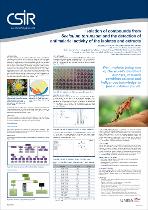 ResearchSpace
ResearchSpace
Isolation of compounds from Sceletium tortuosum and the detection of antimalarial activity of the isolates and extracts
JavaScript is disabled for your browser. Some features of this site may not work without it.
- ResearchSpace
- →
- Research Publications/Outputs
- →
- Conference Publications
- →
- View Item
| dc.contributor.author |
Setshedi, I

|
|
| dc.contributor.author |
Peter, Xolani K

|
|
| dc.contributor.author |
Fouché, Gerda

|
|
| dc.contributor.author |
Myer, M

|
|
| dc.contributor.author |
Dewar, J

|
|
| dc.date.accessioned | 2010-09-02T12:35:11Z | |
| dc.date.available | 2010-09-02T12:35:11Z | |
| dc.date.issued | 2010-09-01 | |
| dc.identifier.citation | Setshedi, I, Peter, X, Fouche, G et al. 2010. Isolation of compounds from Sceletium tortuosum and the detection of antimalarial activity of the isolates and extracts. CSIR 3rd Biennial Conference 2010. Science Real and Relevant. CSIR International Convention Centre, Pretoria, South Africa, 30 August – 01 September 2010, pp 1 | en |
| dc.identifier.uri | http://hdl.handle.net/10204/4316 | |
| dc.description | CSIR 3rd Biennial Conference 2010. Science Real and Relevant. CSIR International Convention Centre, Pretoria, South Africa, 30 August – 01 September 2010 | en |
| dc.description.abstract | The genus Sceletium is classified as part of the Family Mesembryanthemaceae and belongs to the sub-family Mesembryanthemoideae. Some of the names used when referring to this genus are ‘living skeletons’ or ‘skeleton plants’ (http://ujdigispace.uj.ac.za), and popularly known kanna (Khoi) and kougoed (Afrikaans), the latter referring to the use of the plant material by chewing. The genus Sceletium occurs in the south-western parts of South Africa and these plants have an affinity for arid environments; they are also reported to occur in the Namaqualand Rocky Hills, Knersvlakte and Ceres Karoo (Gerbaulet, 1996). The genus is derived from ‘sceletus’ meaning skeleton which refers to the prominent leaf veins visible in the dry and withered leaves. The species are distinguished on the basis of vegetative, flower, fruit and seed characteristics (Gericke and Viljoen, 2008 ) | en |
| dc.language.iso | en | en |
| dc.publisher | CSIR | en |
| dc.subject | Sceletium tortuosum | en |
| dc.subject | Antimalarial | en |
| dc.subject | Malaria | en |
| dc.subject | CSIR Conference 2010 | en |
| dc.title | Isolation of compounds from Sceletium tortuosum and the detection of antimalarial activity of the isolates and extracts | en |
| dc.type | Conference Presentation | en |
| dc.identifier.apacitation | Setshedi, I., Peter, X. K., Fouché, G., Myer, M., & Dewar, J. (2010). Isolation of compounds from Sceletium tortuosum and the detection of antimalarial activity of the isolates and extracts. CSIR. http://hdl.handle.net/10204/4316 | en_ZA |
| dc.identifier.chicagocitation | Setshedi, I, Xolani K Peter, Gerda Fouché, M Myer, and J Dewar. "Isolation of compounds from Sceletium tortuosum and the detection of antimalarial activity of the isolates and extracts." (2010): http://hdl.handle.net/10204/4316 | en_ZA |
| dc.identifier.vancouvercitation | Setshedi I, Peter XK, Fouché G, Myer M, Dewar J, Isolation of compounds from Sceletium tortuosum and the detection of antimalarial activity of the isolates and extracts; CSIR; 2010. http://hdl.handle.net/10204/4316 . | en_ZA |
| dc.identifier.ris | TY - Conference Presentation AU - Setshedi, I AU - Peter, Xolani K AU - Fouché, Gerda AU - Myer, M AU - Dewar, J AB - The genus Sceletium is classified as part of the Family Mesembryanthemaceae and belongs to the sub-family Mesembryanthemoideae. Some of the names used when referring to this genus are ‘living skeletons’ or ‘skeleton plants’ (http://ujdigispace.uj.ac.za), and popularly known kanna (Khoi) and kougoed (Afrikaans), the latter referring to the use of the plant material by chewing. The genus Sceletium occurs in the south-western parts of South Africa and these plants have an affinity for arid environments; they are also reported to occur in the Namaqualand Rocky Hills, Knersvlakte and Ceres Karoo (Gerbaulet, 1996). The genus is derived from ‘sceletus’ meaning skeleton which refers to the prominent leaf veins visible in the dry and withered leaves. The species are distinguished on the basis of vegetative, flower, fruit and seed characteristics (Gericke and Viljoen, 2008 ) DA - 2010-09-01 DB - ResearchSpace DP - CSIR KW - Sceletium tortuosum KW - Antimalarial KW - Malaria KW - CSIR Conference 2010 LK - https://researchspace.csir.co.za PY - 2010 T1 - Isolation of compounds from Sceletium tortuosum and the detection of antimalarial activity of the isolates and extracts TI - Isolation of compounds from Sceletium tortuosum and the detection of antimalarial activity of the isolates and extracts UR - http://hdl.handle.net/10204/4316 ER - | en_ZA |





